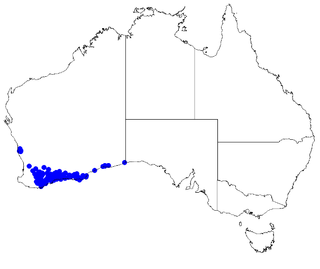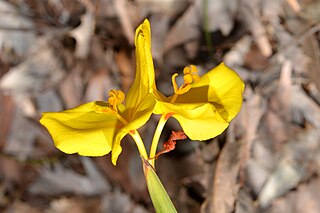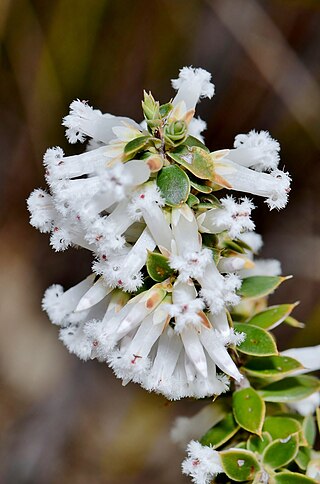
Hibbertia stellaris, commonly known as star guinea flower or orange stars, is a brilliantly orange flowering ground cover from the South Western Australian botanical province. It naturally grows in swamps; despite this, it is extremely sensitive to phytophthora and needs to be grown in well-drained soil in cultivation.

Grevillea endlicheriana, commonly known as spindly grevillea, is a species of flowering plant in the family Proteaceae and is endemic to the south-west of Western Australia. It is an erect shrub with linear leaves, and groups of white, pink tinged flowers.
Wurmbea monantha is a perennial herb that is native to Western Australia. The white to pink flowers are produced between July and September in its native range.

Adenanthos meisneri, commonly known as prostrate woollybush, is a species of shrub in the family Proteaceae. It is endemic to the south-west of Western Australia.

Adenanthos pungens, the spiky adenanthos, is a species of shrub in the family Proteaceae. It is endemic to the south-west of Western Australia.

Caladenia nana subsp. nana, commonly known as the little pink fan orchid, is a plant in the orchid family Orchidaceae and is endemic to the south-west of Western Australia. It is a relatively small orchid with a single hairy leaf and up to three pink flowers with short, spreading, fan-like sepals and petals and which often grows in dense clumps.

Boronia crassifolia is a plant in the citrus family, Rutaceae and is endemic to the south-west of Western Australia. It is a small, slender shrub with pinnate leaves, and yellowish green to brownish, four petalled flowers.

Leucopogon pulchellus, commonly known as beard-heath, is a species of flowering plant in the family Ericaceae, and is endemic to the south west of Western Australia. It is an erect or straggling shrub with erect, linear leaves and short, dense spikes of white, tube-shaped flowers.
Patersonia rudis, commonly known as hairy flag, is a species of plant in the iris family Iridaceae and is endemic to the south-west of Western Australia. It is a tufted, rhizome-forming perennial herb with linear to sword-shaped leaves and violet tepals.

Patersonia umbrosa, commonly known as yellow flags, is a species of plant in the iris family Iridaceae and is endemic to the south-west of Western Australia. It is a loosely-tufted, rhizome-forming, perennial herb with linear to sword-shaped leaves and deep bluish-violet or bright yellow tepals.

Sphaerolobium macranthum is a species of flowering plant in the family Fabaceae and is endemic to the south-west of Western Australia. It is an erect shrub with only a few scale-like leaves, and yellow or orange and red flowers.

Mirbelia ovata is a species of flowering plant in the family Fabaceae and is endemic to the south-west of Western Australia. It is a spreading or prostrate shrub that typically grows to a height of 15–60 cm (5.9–23.6 in) and many branches, covered with woolly or shaggy hairs. Its leaves are egg-shaped, less than 12 mm (0.47 in) long and sharply-pointed. The flowers are arranged in pairs or threes at the base of branches and are yellow or orange and purple and appear from August to October. It was first formally described in 1844 by Carl Meissner in Lehmann's Plantae Preissianae. The specific epithet (ovata) means "wider below the middle".
Sphaerolobium scabriusculum is a species of flowering plant in the family Fabaceae and is endemic to the south-west of Western Australia. It is an erect, leafless shrub that typically grow to a height of 30–60 mm (1.2–2.4 in). Its flowers are pendulous, and usually arranged singly in leaf axils with a short, scale-like bract at the base. The sepals are about 8.5 mm (0.33 in) long and joined at the base for about half their length. The petals are yellow, the standard and wings petals longer than the sepals and the keel usually about 12.5 mm (0.49 in) long. Flowering occurs from September to November.
Caladenia nana, commonly known as pink fan orchid, is a plant in the orchid family Orchidaceae and is endemic to the south-west of Western Australia. It is a clump-forming ground orchid with a single linear leaf and up to 6 pale pink to rose pink flowers.

Leucopogon oxycedrus is a species of flowering plant in the heath family Ericaceae and is endemic to the south-west of Western Australia. It is an erect shrub with variably-shaped leaves with a small, sharp point on the tip, and white, pink or red, tube-shaped flowers.

Guichenotia micrantha, commonly known as small flowered guichenotia, is a species of flowering plant in the family Malvaceae and is endemic to the south-west of Western Australia. It is a low, compact shrub with linear to narrowly egg-shaped leaves and pink flowers in groups of three to six.

Chorizema carinatum is a species of flowering plant in the family Fabaceae and is endemic to the southwest of Western Australia. It is an erect or spreading shrub with sharply-pointed leaves and bright yellow flowers.
Chorizema racemosum is a species of flowering plant in the family Fabaceae and is endemic to the southwest of Western Australia. It is a spreading or erect shrub with leathery, linear leaves, and yellowish-orange and red pea flowers.

Johnsonia acaulis is a plant in the family Asphodelaceae and is endemic to the south-west of Western Australia. It is a rhizomatous, tufted, or grass-like perennial with white, pink or green flowers.

Johnsonia teretifolia, common known as hooded lily, is a plant in the family Asphodelaceae and is endemic to the south-west of Western Australia. It is a rhizomatous, tufted, or grass-like perennial with white, pink or green flowers.
















